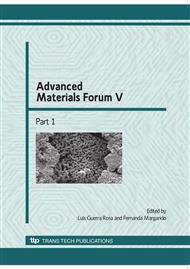[1]
K. Mehta, in: 6th CANMET/ACI Conference International on Fly Ash, Silica Fume, Slag and Natural Pozzolans in Concrete, Vol. 1, edited by V. M. Malhotra. American Concrete Institute (ACI), Bangkok, Thailand (1998), p.1.
DOI: 10.14359/5971
Google Scholar
[2]
H. F. W. Taylor: Cement Chemistry, (Thomas Telford, London, 1997).
Google Scholar
[3]
A. Bentur and M. D. Cohen: J. Am. Ceram. Soc. Vol. 70 (1987), p.738.
Google Scholar
[4]
M. Frías and M. I. Sánchez de Rojas: Cem. Concr. Res. Vol. 27 (1997), p.619.
Google Scholar
[5]
M.I. Sánchez de Rojas, F. Marín, J. Rivera and M. Frías: J. Am. Ceram. Soc. Vol. 89 (2006), p.3701.
Google Scholar
[6]
H.F.W. Taylor, K. Mohan, and G. K. Moir: J. Am. Ceram. Soc. Vol. 68 (1985) p.685.
Google Scholar
[7]
J.M. Khabit and S. Wild: Cem. Concr. Res. Vol. 26 (1996), p.1545.
Google Scholar
[8]
P.S. Silva and F. P. Glasser: Cem. Concr. Res. Vol. 23 (1993), p.627.
Google Scholar
[9]
M. Frías and M.I. Sánchez de Rojas: Cem. Concr. Res. Vol. 35 (2005), p.1292.
Google Scholar
[10]
M. Frías: Adv. Cem. Res. Vol. 18 (2006), p.1.
Google Scholar
[11]
J. Pera and A. Amrouz: Adv. Cem. Based Mat. Vol. 7 (1998), p.49.
Google Scholar
[12]
M. Frías, M.I. Sánchez de Rojas, and J. Rivera in: 8th CANMET/ACI Inter. Conference on Fly Ash, Silica Fume, Slag and Natural Pozzolans in Concrete, Edited by V.M. Malhotra. Las Vegas, U.S.A. (2004), p.879.
DOI: 10.14359/14034
Google Scholar
[13]
M. Frías, M.I. Sánchez de Rojas, O. Rodríguez, R. García and R. Vigil: Adv. Cem. Res. Vol. 20 (2008), p.23.
Google Scholar
[14]
I. Vegas, M. Frías, J. Urreta and J.T. San José: Mater. Construcc. Vol. 56 (2006), p.49.
Google Scholar
[15]
M. Frías, E. Sabador, S. Ferreiro, M.I. Sánchez de Rojas, R. García and R. Vigil: Mater. Construcc. Vol. 58 (2008), p.67.
Google Scholar
[16]
European standard UNE EN 197-1: 2000/A1: 2005, Composition, specifications and conformity criterions for common cements.
Google Scholar
[17]
European standard UNE EN 196-1: 2005, Methods of testing cement. Part 1: Determination of strength.
Google Scholar
[18]
European standard UNE EN 196-3: 2005, Methods of testing cement. Part 3: determination of setting time and soundness.
Google Scholar
[19]
European standard UNE EN 83811: 1992 EX, Mortars. Test methods. Fresh mortars. Detemination of consistence. Flow table (reference method).
Google Scholar
[20]
M. Frías, O. Rodríguez, R. García and I. Vegas: J. Am. Ceram. Soc. Vol. 91 (2008), p.4044.
Google Scholar


